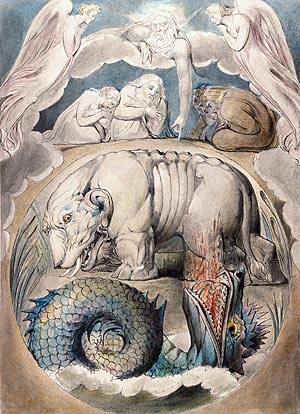
Visionary and nonconformist William Blake (1757–1827) is a singular figure in the history of Western art and literature: a poet, painter, and printmaker. Ambitiously creative, Blake had an abiding interest in theology and philosophy, which during the age of revolution, inspired thoroughly original and personal investigations into the state of man and his soul. In his lifetime, Blake was best known as an engraver; he was later recognized for his innovations across many other disciplines.
In the Morgan's first exhibition devoted to Blake in two decades, former director Charles Ryskamp and curators Anna Lou Ashby and Cara Denison have assembled many of Blake's most spectacular watercolors, prints, and illuminated books of poetry to dramatically underscore his genius and enduring influence. William Blake's World: "A New Heaven Is Begun"—the subtitle a quote from Blake referring to the significance of his date of birth—is on view from September 11, 2009, to January 3, 2010.
The show includes more than 100 works; among the many highlights are two major series of watercolors rarely displayed in their entirety. The twenty-one watercolors for Blake's seminal illustrations for the Book of Job—considered one of his greatest works and revealing his personal engagement with biblical texts—were created about 1805–10. Also on view are twelve drawings illustrating John Milton's poems L'Allegro and Il Penseroso, executed about 1816–20. Both series were undertaken for Blake's principal patron, Thomas Butts.
In addition to the superlative watercolor series—twenty-one illustrations of the Book of Job and twelve designs illustrating Milton's L'Allegro and Il Penseroso—other important drawings are on display, including Fire (ca. 1805), which addresses the subject of war. The more fully expressed Continental Prophecies, a series of three illuminated books, further showcase Blake's talents as a visual artist and his passionate interest in politics.
Blake's fame as a poet is seen in his fair copy of ballads known as The Pickering Manuscript, named after its early owner and publisher. Giving voice to Blake's well-known poem "Auguries of Innocence," found in the manuscript, is the actor Jeremy Irons, who has also recorded the shorter poem, "Tyger." These can be heard on a gallery listening station.
Blake supported himself with his engravings, and a selection of his prints—many of which are extremely rare impressions—documents this important aspect of his production. A magnificent example of Blake's largest print, touched with watercolor by the artist, depicts Chaucer's Canterbury Pilgrims. With this work the artist hoped for commercial success, something he was unable to secure in his lifetime.
Among Blake's crowning achievements as a visual artist and poet are his illuminated books, such as Songs of Innocence and of Experience: Shewing the Two Contrary States of the Human Soul (ca. 1794). These works, which also showcase his exceptional technical skills, reflect medieval manuscript illumination and the interrelationship between word and image. Also on view is the only dated copy of Blake's dramatic The Marriage of Heaven and Hell.
Shedding light on the artistic milieu surrounding Blake are a number of works by friends and contemporaries, including drawings by younger artists such as John Linnell (1792–1882) and members of a group that assembled around Blake and called themselves the Ancients. Also represented are works by painters such as Samuel Palmer (1805–1881) and Henry Fuseli (1741–1825).
This exhibition is made possible through the generosity of Fay and Geoffrey Elliott.
William Blake (1757–1827)
Behemoth and Leviathan, ca. 1805–10
[Book of Job, no. 15]
Pen and black and gray ink, gray wash, and watercolor, over faint indications in pencil, on paper
10 1/16 x 7 3/4 inches (272 x 197 mm)
Purchased by Pierpont Morgan, 1903; 2001.77
